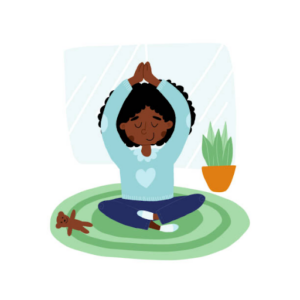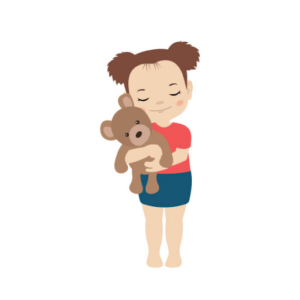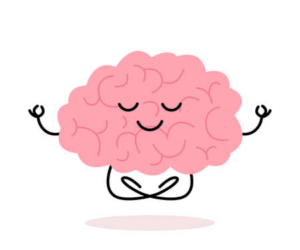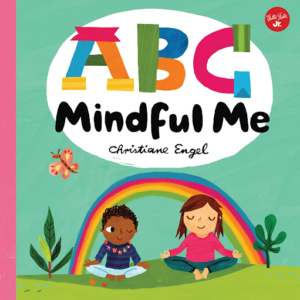
In today’s world, we all have a lot to juggle that requires our attention including school, extracurricular activities, technology, friendships, and relationships. It can be easy to get through our day feeling as if we moved from task to task without a break! How can we slow down, increase attention, promote self-esteem, and reduce overall stress and anxiety for our children?
By incorporating mindfulness and meditation into our everyday routines, we can build our attentional skills and prepare our children for coping with a variety of feelings, emotions, and situations!
What is Mindfulness?
Mindfulness is a practice that can be practiced by anybody, anywhere. Mindfulness can be practiced in a multitude of ways, including breathing exercises, mindful movement, mindful snacking, listening to music, guided meditation, or simply intentionally being aware and present in the moment. Children of all ages (and adults too!) can practice mindfulness. While mindfulness can often help clear your mind, the goal is not to “stop thinking” but rather to bring a new level of awareness to our thoughts, feelings, and actions.
Mindfulness: Littles to Grown-Ups!
Mindfulness: 2-3 years
We can engage children under the age of three in short, intentional mindfulness moments to promote focus, emotional awareness, and emerging self-regulation skills. For children of this age, we want to keep our mindfulness activities between one-to-three minutes. See below for an example of how we can join and model mindfulness for our younger children!
Exercise: Teddy Bear Breathing

To practice teddy bear breathing, first have your child pick out their favorite stuffy, lovey, or teddy bear. Ask your child to lay down on their back on a soft surface (bed, rug, or couch!). Place the teddy bear on their tummy. Use your own body to model taking
big, slow, deep belly breaths and watch as the teddy bear moves up and down as you breathe in and out! Together, pick a number of breaths or amount of time to complete the exercise together and watch as the teddy bear falls and rises with your breath!
Mindfulness: 4-6 years
For your school aged child, we can incorporate our five senses to promote awareness of our bodies, social environments, and senses. Exploring our environments in this way can increase our body awareness, social awareness, and attentional skills!
Exercise: 5-4-3-2-1 mindfulness technique
To practice the 5-4-3-2-1 mindfulness technique, ask your child to find a comfortable seat. Review the five senses, including sight, hearing, touch, smell, and taste. After taking two deep breaths with your child, ask them to open their eyes and quietly find and describe five things they can see around them. Next, join your child in finding four things they can hear. Explore sounds in the environment, both loud and quiet (e.g., the sound of cars driving down the street, the sound of a television in the background.) After exploring your sense of hearing, guide your child to bring awareness to three things they can feel, including clothes, their seat, and the temperature of the room. Finally, guide your child to identify two things they can smell and taste. If possible, you can provide a snack or drink of water to mindfully explore these last two senses!
Mindfulness: 7+ years
For these older-aged children, we can begin exploring the connection between our thoughts, feelings, and behavior through mindfulness. Mindfulness for this age group can incorporate breathing, body awareness and movement to increase focus and decrease anxiety!
Exercise: Body Scan
To engage in progressive muscle relaxation through a body scan,

ask your child to join you in a comfortable position, sitting, lying down, or kneeling. Guide your child through a number of deep breaths with you to calm your body and focus your brain. To begin the body scan, prompt your child to bring their attention to their head and face.
Model tensing your head and facial muscles for three seconds, then gradually release the tension and return to a
resting position. Repeat the tense/release cycle down through the whole body, from the shoulders down to toes. Incorporate breathing throughout and model self reflection at the end of the exercise, including: “How did our bodies feel before? How did they feel after? When did our mind wander? What helped us bring our attention back to our bodies?”
Mindfulness Books/Resources
Check out the resources below for additional ways to incorporate mindfulness into your child’s routine!
Books for Children
- 0-3 years
- 4-6 years
- 7+ years
Online Resources
- Sesame Street Monster Mediations (Available on Youtube)
- Headspace Kids (Available in the App Store)
- Calm Kids (Available online and in the App Store)
Questions or concerns?
If you have questions or concerns about your mindfulness or your child’s development, please contact us at info@playworkschicago.com or 773-332-9439.
Elizabeth Gilbert, LSW
Licensed Social Worker
Gary, J. (2019, October 25). The Power of Mindfulness: How a meditation practice can help kids become less anxious, more focused. Child Mind Institute. Retrieved Februrary 28th from https://www.washk12wellness.org/uploads/2/9/9/6/29960495/the_power_and_benefits_of_mindfulness_meditation__child_mind_institute.pdf
Picture Credits:
istockphotos
123rf

